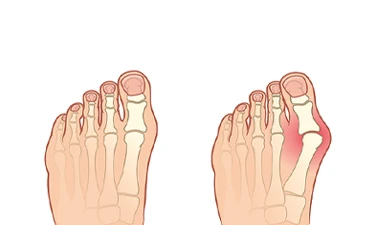

It is a foot deformity that occurs with the formation of a protrusion on the edge of the big toe, which is actually caused by the progressive bending of the comb bones.

Permanent treatment of this disease is only possible with surgical intervention.
Non-surgical treatments can be listed as using insoles, using a roller between the toes, and doing exercises. However, this type of non-surgical treatment does not change the appearance of the feet, but can only reduce pain and callus formation. Nor can they prevent the progression of the disease.
Surgical treatment is generally performed for two reasons.
-Aesthetic
-Pain
Anyone who wants to have a more beautiful foot, who has difficulty in wearing shoes due to pain and deformity, whose foot wounds and calluses do not heal, who wants to have a narrower foot (which is known as 'cinderella foot'), who has no problems in general health, can undergo this surgery. it could be.
It can be applied to anyone who has completed bone development (over 18 years of age). There is no age limit. Advanced age can delay healing.
Basically, surgical options are divided into two as soft tissue and bone surgeries. Although the surgical procedure varies according to each foot, it basically includes cleaning the protrusions called bunions (bunionectomy), relaxing the muscles that cause pain (tenotomy) – these two procedures are called soft tissue surgeries – and bone shifting.
The biggest advantage of soft tissue surgeries is that they can be stepped on quickly and heal quickly. However, in advanced cases, it is not sufficient alone and the risk of recurrence is higher in patients who have only soft tissue surgery.
Bone surgeries are of 2 types: osteotomy (cutting the bent bone and bringing it to the appropriate position) and arthrodesis (fixing the damaged joint by correcting). The appropriate option is determined according to the patient's foot deformation status. Permanent tiny implants can be placed in patients undergoing bone surgery.
Although surgery is usually performed under local anesthesia, it can also be performed under general anesthesia.
The patient should inform the doctor about the drugs he used before the operation, if any, and should stop the drugs that the doctor deems appropriate a few days before (drugs such as blood thinners).
Although the duration of the operation may vary according to the surgical option and the severity of the deformity, it takes 45-90 minutes for one side, and after the operation, the patient is observed in the operating room rest room for a while, and after the anesthesia effect disappears, he is taken to his room.
Generally, 1 night of hospitalization is sufficient. After pain control is done, the patient is discharged with a special shoe.
Although it may vary according to the severity of the deformity, patients can step on their feet after the surgery. Generally, the operation area will be swollen for 3-6 weeks due to edema. Patients can leave Istanbul by showing wound care on the 3rd day after surgery.
For passengers traveling by plane, it may be necessary to wear antiembolic stockings after surgery. Long standing for the first 6 weeks can often be painful. For this reason, it would be more appropriate for patients who have had bone rectification surgery to adjust their condition to rest at home for the first 2-4 weeks if they are bilateral. Patients who have had bone surgery should contact their doctor to see if the union is complete by having a plain radiograph 6 weeks after the surgery. It is possible for the athletes to return to the field with 100% performance at the end of 3 months.
• Swelling: Although it is usually temporary, swelling that may require physical therapy may occur.
• Infection: There is this risk, especially in diabetics and smokers, and smoking should not be smoked if possible during the recovery period after the operation. Due to infection, serious complications such as wound care follow-ups, re-surgical cleaning and, more rarely, skin transplantation can be observed rarely.
• Scar formation
• Complex regional pain: In a rare part of the patients, the pain may last longer than 6 weeks and may require treatment.
• Deep vein thrombosis: This risk can be reduced by arranging appropriate stockings and medications if deemed necessary after the surgery due to clots that may occur in the veins due to bone surgery.
• Nerve compression: Compression of the capillary nerves in the operation area is also a rare condition.
• Joint stiffness: In patients with advanced curvature, joint stiffness can sometimes be seen apart from arthrodesis (joint freezing).
• Prolonged healing: Recovery may be delayed due to patient-related reasons. The figures given are the average values of scientific studies and may vary depending on the surgical technique and the patient.
Although all risks are less than 10%, 1% of foot surgeries can lead to serious complications.
-Yes, both feet can be operated in a single session. There is no problem.
- Whatever method your doctor deems appropriate and you approve is applied. In other words, spinal anesthesia, general anesthesia, or local numbing methods can be used.
- Thanks to the special sandal that will be given to you after the operation, it will be possible to stand up on the same day or the next day, depending on the difficulty of your operation.
After the Hallux Valgus operation, 6 weeks are needed for the bones to fuse. After the doctor's approval at the end of 6 weeks, the person starts to return to his normal life.
- After the operation, it may be possible for your finger to return to its original state, but due to technical errors in the operation or heavy genetic factors.